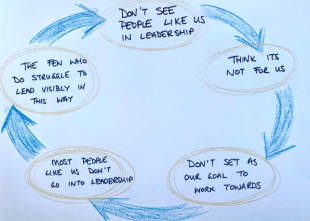I was once categorically told by a course teacher that you don’t find people who exhibit a ‘facilitator’ leadership style (people-focused over task-focused, empowering over directive) in leadership positions. “Apart from perhaps as the HR Director,” she said disparagingly. What a ridiculous thing to say, I thought. The sad part is, it’s true, ‘facilitator’ types are much less represented in senior positions compared to the population as a whole, and what’s worse is nearly half of women identify as this personality type.
For me, the end goal of diversity in leadership is to have a balance in styles and thought processes - not just to have equal numbers of men and women in leadership. The balance in styles maximises our ability to identify the right strategy and motivate everyone to deliver it. However, women heavily outnumber men in personality types underrepresented in leadership positions, so gender balance is a good proxy measure.
But one person with a different style is not enough. They will usually ‘fit in’ with the presiding culture, negating their impact on the diversity of thought of the organisation. It is also widely recognised that without role models that we can relate to, we don’t imagine the role is suitable for us and don’t work towards it. We are stuck in a cycle!

Men are also victims of this perception. I know many very capable men who are people-focused and open to others’ ideas that didn’t see a future for themselves and switched careers, all because they didn’t see people like themselves in leadership positions.
We all benefit because if the culture of the organisation changes, it creates more space for people to grow, take ownership and contribute to strategy at all levels.
| Traditional ‘driver’ leadership style | Alternative ‘facilitator’ leadership style |
| sets direction; is directive and assertive | collaborates; wants to understand context & different points of view |
| ‘owns’ ideas (even if they didn’t come up with them) | amplifies the individuals and teams who were the source of ideas |
| expresses direction with authority, certainty, and conviction | openly acknowledges uncertainty |
| expects subordinates to toe the line | is accepting of challenge, and in return expects ownership at all levels |
| focuses on their vision as the single right answer | acknowledges there are many different ways of moving forward (and helps their teams to pick one!) |
In reality, a good leader chooses the right approach in the right situation. Leaders need to be adept at using other styles as well as their natural approach. If there is a crisis or a large capability gap in the team, the facilitator approach isn’t likely to get the results needed and may result in disaster.
Without a strong focus on diversity in our leadership, we aren’t exposed to all approaches. Future ‘facilitator-leaning’ leaders don’t emerge as they leave to pursue other careers. Existing leaders don’t recognise there is a missing string to their bow as they rarely see others using this approach. We all continue to believe that those who don’t fit the mold, aren’t fit to be leaders. We all miss out on the opportunity to work in a rounded culture that values people as well as outcomes and acknowledges emerging context and strategy, not just the HIPPO (highest paid person’s opinion).
